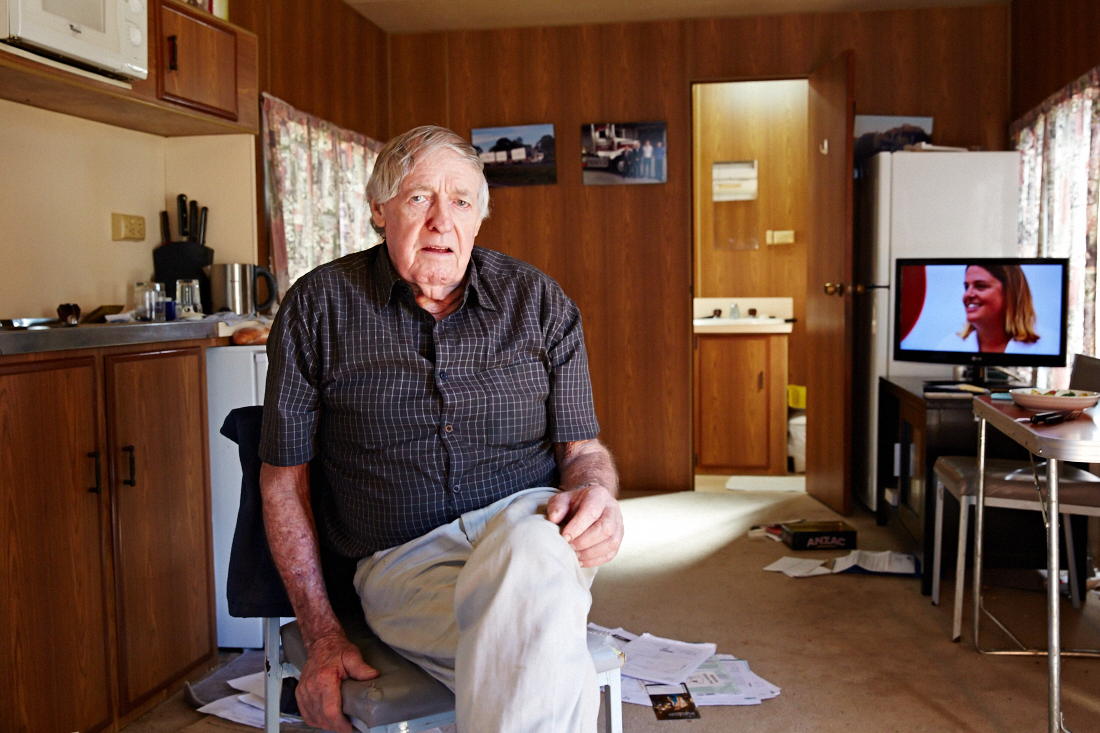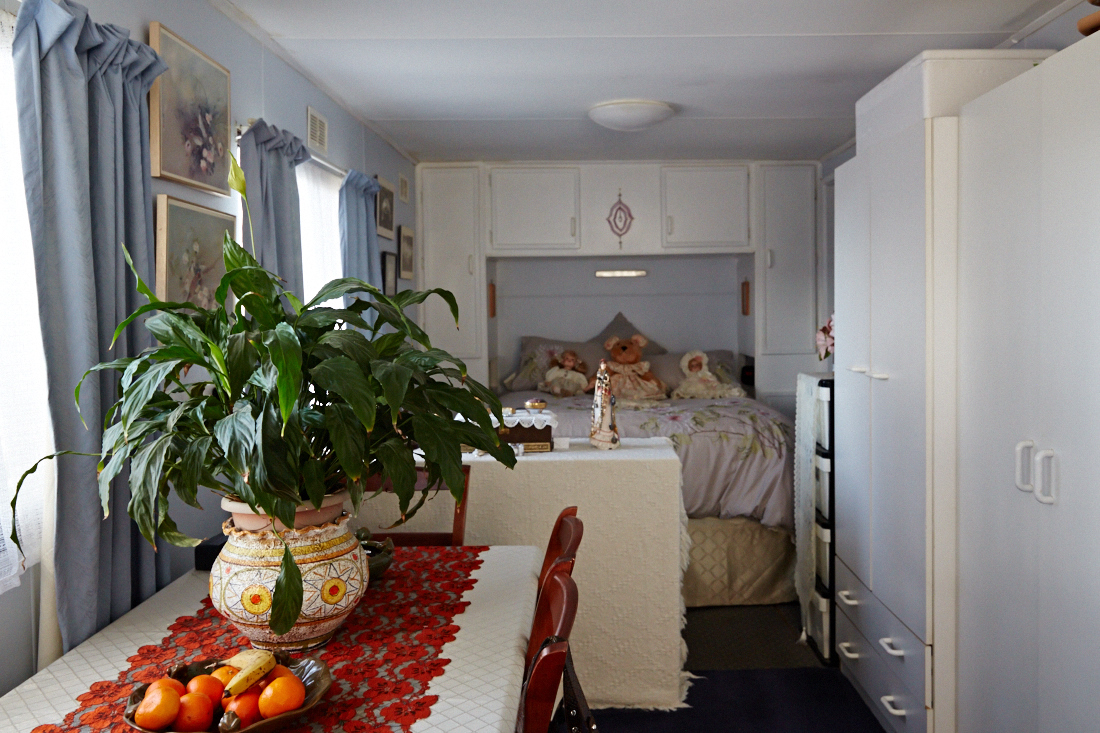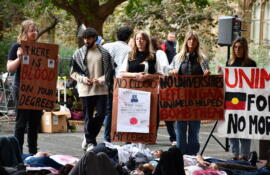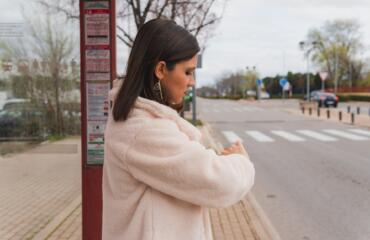
Former truckies’ boss John Wettenhall in his cabin at Highlands, Seymour, where he is one of just three permanent residents. PIC: Cameron Clarke















Julie Henwood has everything she needs. The 72-year-old grandmother of four shows off her new blinds, which will keep her cool in the summer, and her freestanding electric heater, which warms up the 90-square-metre caravan and attaching annexe she calls home.
“I’m getting older and I like all the comforts,” she says.
Ms Henwood, who retired on a disability pension at 58, is one of three permanent residents of Highlands Caravan Park – a flat, flood-prone block of land off a business strip in Seymour, 110 kilometres north of Melbourne. The rest of the people here are tourists or short-term contractors working at the nearby Puckapunyal military base.
Ms Henwood moved to Highlands 10 years ago. She pays $95 a week to stay on her plot, which she has kitted out with an ensuite bathroom and veranda. A carefully tended garden wraps around the caravan so you can’t see its wheels. It’s not going anywhere.
She says she has no interest in traditional home ownership: “Been there, done that.”
Ms Henwood is one of about 5000 Victorians who live permanently in caravan parks, according to a report published by researchers at RMIT and Swinburne University.
Caravan parks are often characterised as affordable pit stops for touring families and seniors, so-called “grey nomads”, who sell their houses when they retire and use the money to travel Australia. But for some Victorians, especially fixed-income pensioners or bachelors on a budget, caravan parks are often the best – or only – permanent housing option in an increasingly unaffordable rental market.
“With limited money options, it’s a liveable choice,” says Dr Janice Newton, a Federation University researcher, who spent five years touring Victorian caravan parks for her just-published book, Parkland: When Caravan is Home.
Dr Newton found “considerable diversity” in park life, which can range from higher-end communities of seniors in idyllic country settings to crowded and dingy parks in Melbourne’s outer suburbs. Most of the people she interviewed were working-class Australians, who ended up in caravan parks because of cost, health or family constraints.
Park life in Victoria
Caravan parks: 420
In Melbourne region: 23
Around Shepparton: 30
Permanent residents: 5000
In greater Melbourne parks: 1500
In Shepparton region: 330
Parks with permanent residents: 56%
Melbourne parks with at least one permanent resident: 90%
Shepparton parks with at least one permanent resident: 86%
Source: On the Margins: Permanent Residents in Caravan Parks report, Swinburne University and RMIT University, July 2013
But a 2013 study for the Australian Housing and Urban Research Institute identified a trend toward the “gentrification” of some Australian parks, where park owners show a preference for higher-income “owner-renters”, people who own their caravan or cabin and rent the land. This can come at the expense of lower-income “renter-renters”, people who rent the caravan and the land it sits on.
Reflecting this trend is the rise in the popularity of cabins – self-contained units with adjoining amenities – and manufactured housing estates for seniors.
Ray Jones, a retired refrigeration mechanic who worked for Coca-Cola, manages Highlands with his wife, Nettie. He says he would target seniors if he owned the park.
“I don’t have a problem with permanents,” he says. “It’s more a case of being able to control them and pick who comes in.”
The Victorian government defines caravan park residents as people who live in a caravan park for at least 60 consecutive days or have signed a residency agreement with the park owner.
Mr Jones, who leases the park from its private owner, says government regulations protecting permanent residents can make it more difficult for park managers to control unruly tenants.
“If Julie didn’t pay for electricity, I wouldn’t be able to turn it off,” he says. “We have to go to court or VCAT [Victorian Civil and Administrative Tribunal] to get her to pay.”
Dr Newton says that mixed parks, with both permanent residents and tourists, are increasingly rare. A rural park in a picturesque location might target traveling seniors, while a regional park might house people working on nearby road or windmill construction.
The market is “diversifying and specialising,” she says.
Ray Collinson, a 73-year-old former mill worker, lives 83 kilometres north along the freeway from Highlands in Shepparton’s Strayleaves Caravan Park, a mixed park near the SPC cannery.
He moved to the park when his marriage broke down about eight years ago.
“When things went wrong there, I moved here,” he says.
Like Ms Henwood, Mr Collinson has an annexe attached to his caravan, which he uses as a TV den, workshop and storage area for his fishing rods. But he shares the park’s communal toilets and showers with other residents, grey nomads and backpackers doing seasonal shifts at the cannery.
Mr Collinson’s next-door neighbour and friend, Lance Pilgrim, has lived with his wife in Strayleaves for 17 years. A collection of potted plants sits around his cabin, emblazoned with the word “Komfort” above his front window.
“We had a house in Shepp,” Mr Pilgrim says. “We had bad neighbours; we used to get the police there all the time. So we sold our house and came here to see what we were gonna do and we’re still here.”
The Pilgrims own their cabin and annexe, but they pay about $85 a week to stay in the park. When they decide to go traveling in their separate caravan, they pay a $50-per-week storage fee on the cabin.
Shanny Gordon, of Housing for the Aged Action Group, says park life can be an appealing choice for seniors, who are attracted to the relatively affordable upfront costs of “movable dwellings.”

“It is an option that caters for older people who may have too much money for public and social housing, but have too little for regular home ownership or an ingoing amount into a self-funded retirement village,” she says.
Strayleaves manager Debbie McKenzie (left) says about 35 people live in the park for most or all of the year. They account for a sizeable chunk of cash flow for the park, though she carefully manages what she calls its “culture”.
“This is a retired area,” Ms McKenzie says, gesturing toward a quiet corner of the park where Ray and Lance live. She makes sure that like-minded residents are situated together. Younger bachelors live in a more sociable area of the park, where they often congregate.
“They’ve lost a licence, lost a job, lost a wife,” she explains.
Ms McKenzie says that downsizing at the SPC factory and Shepparton’s notoriously sinister ice problem have changed the business.
“Ice has taken over,” she says. “More people are getting evicted out of houses and more people are wanting to move out on their own at a younger age. And that puts more pressure on the rental market but they’re not rentable people. No-one wants them.”
Like many caravan parks in Victoria, Strayleaves prefers to have seniors over 55.
“They’re the best if you can get them. The grey nomads,” Ms McKenzie says. “They’re on a mission, they know what they want.”
Both park managers, Mr Jones and Ms McKenzie, say they could live in cabins, with amenities, but not caravans, which are smaller and more cramped.
“I could set up a cabin and live here permanent,” Ms McKenzie says. “It’s a little house.
“But I couldn’t live in an old van like the low-income ones do and rough it like the old blokes do.”
Researcher Dr Newton says she found that most permanent residents were happy with their living arrangements, though caravan-park living comes with its challenges.
Residents are often dependent on the competency of their park managers.
“Even when [the former manager] was here, I thought, ‘Even if I won lotto, I wouldn’t want to move from here.’ Cause I’m comfortable. I have everything.” — Highlands permanent resident Julie Henwood
Ms Gordon, of HAAG, says: “There is an inherent power imbalance in these villages and a tension will always exist in some form due to the village being the residents’ home but being the operator’s business.
Mr Jones took over the lease at Highlands 18 months ago, but Ms Henwood says the previous park manager left the property in a state of disrepair and often fought with tenants.
She claims she was threatened with high rent if she kept extending her garden.
“That’s the type of person he was,” she says.
Mr Jones adds: “The front lawn was all car parts and axles, just leaves and rubbish everywhere. There was gas bottles, big gas bottles, all buried underneath the leaves and the previous owner didn’t care.
But Ms Henwood says she never had any intention of leaving.
“Even when [the former manager] was here, I thought, ‘Even if I won lotto, I wouldn’t want to move from here.’ Cause I’m comfortable. I have everything.”



